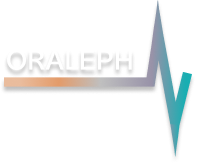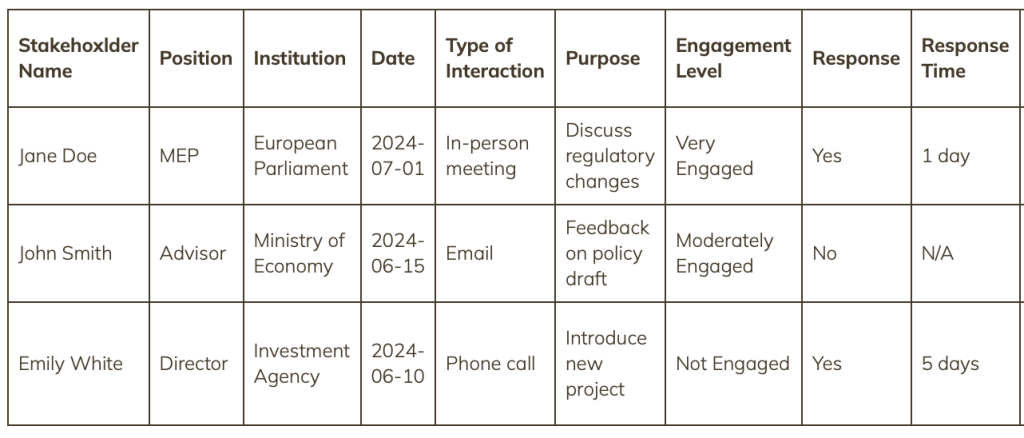Knowing your internal and external stakeholders is key to build a sucessful Public Affairs strategy. Mapping them is the first step to dive deep into the challenges and opportunities that they can represent for your business.
However, the mere identification of your stakeholders is often not enough to track the quality of your interactions with them. That is why we ideated the Stakeholder Influence Score as a measurement of the success of your interactions and as a powerful tool to plan your future stakeholder engagement.
What is the Stakeholder Influence Score?
The Stakeholder Influence Score (SIS) is a quantitative metric designed to assess the effectiveness and impact of your engagement with key stakeholders.
It is calculated by considering three critical factors:
- the frequency of your interactions
- the responsiveness of the stakeholders, and
- the retention rate of these stakeholders over time.
Why you should measure the influence of your stakeholders

Improve your decision-making procress and track your progress
The SIS provides a clear, quantifiable measure of stakeholder engagement, allowing organizations to make informed decisions about where to focus their efforts and resources. By identifying highly influential stakeholders, companies can prioritize their interactions and strategies effectively.
Morever, the SIS serves as a benchmark for monitoring the effectiveness of stakeholder engagement over time. Regularly calculating this score helps track improvements, identify trends, and highlight areas needing adjustment, ensuring continuous enhancement of stakeholder management practices.

Allocate your resources efficently
By pinpointing which stakeholders require more attention and which are already well-engaged, organizations can allocate their resources more efficiently. This ensures that time, effort, and funds are directed towards the most impactful interactions.

Mitigate potential risks and identify mid-term challenges
Engaging effectively with stakeholders can help identify potential risks and challenges early on. By maintaining strong relationships and open lines of communication, organizations can proactively address concerns, reducing the likelihood of conflicts and ensuring smoother project execution.
Stakeholder Influence Score Formula
Now that you know how useful the SIS can be, you can have a glimpse on how to calculate it. The SIS is a number between 0 and 1 which you can easily calculate following the formula:

A higher SIS indicates more effective stakeholder engagement, characterized by frequent meaningful interactions, prompt and positive responses, and sustained interest over time.
Conversely, a lower SIS signals the need for strategy adjustments to improve communication and strengthen relationships. By tracking and optimizing these components, organizations can ensure they maintain strong, productive, and lasting connections with their key stakeholders.
Optimal, bad and acceptable SIS: Three basic scenarios
Now that you have learned how to calculate the SIS, let’s have a look at three scenarios that you may encounter while measuring the SIS of your stakeholders.
SIS between 0,5 and 1: Excellent stakeholder engagement
Jane Doe is a member of the European Parliament with you work on environmental topics with. She is highly engaged and responsive, with interactions occurring monthly. She responds to 90% of communications within a day, showing strong support for the regulatory changes that you bring to the table.

Stakeholder: Jane Doe, MEP, European Parliament
Frequency of Engagement (FoE): 1 interaction per month
Response Rate (RR): 0.90
Stakeholder Retention Rate (SRR): 0.95

SIS between 0,3 and 0,5: Acceptable stakeholder engagement
Mary Smith is an advisor at the Ministry of Economy and is crucial when it comes to tax rates for the purchase of your business car fleet. The team contacts him three times per month, and he responds 60% of the times. The Stakeholder Retention Rate is 0.70, indicating a reasonable level of ongoing engagement. However, the delayed responses and moderate engagement level suggest there is room for improvement.

Stakeholder: Mary Smith, Advisor, Ministry of Economy
Frequency of Engagement (FoE): 3 interactions per month
Response Rate (RR): 0.60
Stakeholder Retention Rate (SRR): 0.70

SIS between 0 and 0,3: Bad stakeholder engagement
John White is a director at the Investment Agency and you need his support to open you new business site in the country. Unfortunately, he is not very engaged. Despite five interactions per month, he only responds to 20% of your communications, usually after several days. The low Stakeholder Retention Rate of 0.50 indicates a lack of sustained interest and involvement, resulting in a low Stakeholder Influence Score and highlighting the need for a revised engagement strategy.

Stakeholder: John White, Director, Investment Agency
Frequency of Engagement (FoE): 5 interactions per month
Response Rate (RR): 0.20
Stakeholder Retention Rate (SRR): 0.50

How to improve your SIS: Our masterplan
In order to improve your SIS you should focus on: the frequency of the engagement with your stakeholders, on optimising their response rate and on increasing their retention rate.
First, you should reduce unnecessary interactions while maintaining meaningful engagement.
In order to do that, you can:
- Schedule regular but not excessive meetings or communications.
- Tailor your communications to the stakeholder’s preferences and interests to make each interaction valuable.
- Choose the most appropriate communication channels (e.g., in-person meetings, emails, phone calls) based on the stakeholder’s preferences.
Second, you have to aim at increasing the likelihood of stakeholders responding to communications.
For example, focus on:
- Clear and Concise Messaging
- Timely Follow-Ups
- Build a personal relation and trust
Third, you want to maintain stakeholder engagement over time
In order to do that, you should:
- Invest time in building and nurturing relationships with stakeholders. Understand their needs, interests, and concerns.
- Offer value in your interactions, such as providing useful information, addressing their concerns, or involving them in decision-making processes.
- Keep stakeholders informed about project progress, changes, and how their input is being utilized, with regular updates
- Acknowledge and appreciate the stakeholder’s contributions and support.
How can we help you improving your SIS
Engagement Plan
We develop a comprehensive engagement plan by outlining specific strategies for each stakeholder, including the frequency and type of interactions.
We set clear objectives for what you want to achieve with each interaction
Technological Leverage
We use CRM systems and engagement tools to streamline communication, track interactions, and analyze engagement patterns.
We implement sentiment analysis tools to gauge stakeholder attitudes and adjust strategies accordingly.
Ad-hoc Training
We provide training for your team on effective stakeholder communication and engagement techniques.
We organise aligments to encourage a collaborative approach within your team to ensure consistent messaging and strategy alignment.



No responses yet